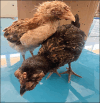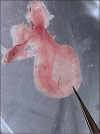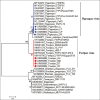Molecular characterization of fowl and pigeon pox viruses: A recent outbreak in Libya
- PMID: 40557072
- PMCID: PMC12184477
- DOI: 10.5455/OVJ.2025.v15.i5.31
Molecular characterization of fowl and pigeon pox viruses: A recent outbreak in Libya
Abstract
Background: Poxvirus infections in poultry, particularly fowl poxviruses (FPV), pose significant challenges to the global poultry industry. A notable outbreak of cutaneous fowl (FP) and pigeon pox in Libya has primarily affected backyard chickens, pigeons, and some commercial layers, marking the region's first official record of these viruses.
Aim: This study aimed to isolate, identify, and characterize FP and pigeon pox viruses (PPVs) associated with the outbreak.
Methods: Histopathological examinations were conducted alongside clinical observations of lesions in affected chickens and pigeons. Virus isolation was performed using embryonated chicken eggs, and molecular diagnosis was achieved via polymerase chain reaction targeting the P4b core protein gene. Sequencing and phylogenetic analyses were also performed.
Results: Characteristic lesions, such as wart-like growths and scabs, were observed in backyard chickens and pigeons. Histopathological analyses confirmed the presence of eosinophilic intracytoplasmic inclusion bodies. Molecular analysis revealed high genetic similarity among the four FPV isolates, which were 100% identical to selected isolates from Iraq, Iran, and Brazil. The PPV isolates also showed significant genetic homogeneity, with 100% identity to strains from Egypt and India and high similarities to other isolates.
Conclusion: Our findings underscore the need for further investigation into the epidemiology and transmission dynamics of fowlpox and PPVs. Future research should focus on the genetic diversity of PPVs and their implications for pathogenicity and host specificity. Ongoing global surveillance and genetic analysis of avian viruses are crucial for understanding their impact on poultry populations and developing effective disease management strategies.
Keywords: Backyard chicken; Fowl pox; Libya; Pigeon; Pigeon pox.
Conflict of interest statement
Abdulatif Asheg hereby declares that he has no financial, personal, or professional conflicts of interest related to the subject matter of this publication. If any potential conflicts arise in the future, he commits to disclosing them promptly to the relevant parties to ensure transparency and maintain the integrity of the work. Abdulatif Asheg [Date] 29-3-2025.
Figures










Similar articles
-
Development of a Multiplex PCR Assay for Rapid Differentiation of Fowlpox and Pigeonpox Viruses.Avian Dis. 2024 Mar;68(1):33-37. doi: 10.1637/aviandiseases-D-23-00042. Avian Dis. 2024. PMID: 38687105
-
Molecular and pathological screening of the current circulation of fowlpox and pigeon pox virus in backyard birds.Poult Sci. 2024 Dec;103(12):104249. doi: 10.1016/j.psj.2024.104249. Epub 2024 Aug 22. Poult Sci. 2024. PMID: 39418793 Free PMC article.
-
Characterization of canarypox-like viruses infecting endemic birds in the Galápagos Islands.J Wildl Dis. 2005 Apr;41(2):342-53. doi: 10.7589/0090-3558-41.2.342. J Wildl Dis. 2005. PMID: 16107669
-
Signs and symptoms to determine if a patient presenting in primary care or hospital outpatient settings has COVID-19.Cochrane Database Syst Rev. 2022 May 20;5(5):CD013665. doi: 10.1002/14651858.CD013665.pub3. Cochrane Database Syst Rev. 2022. PMID: 35593186 Free PMC article.
-
Systemic pharmacological treatments for chronic plaque psoriasis: a network meta-analysis.Cochrane Database Syst Rev. 2021 Apr 19;4(4):CD011535. doi: 10.1002/14651858.CD011535.pub4. Cochrane Database Syst Rev. 2021. Update in: Cochrane Database Syst Rev. 2022 May 23;5:CD011535. doi: 10.1002/14651858.CD011535.pub5. PMID: 33871055 Free PMC article. Updated.
References
-
- Abdallah F.M., Hassanin O. Detection and molecular characterization of avipoxviruses isolated from different avian species in Egypt. Vi. Genes. 2013;46:63–70. - PubMed
-
- Audarya S., Riyesh T., Kumar N., Chhabra D., Sikrodia R., Sharda R., Barua S., Garg U. Molecular diagnosis of a cutaneous form of pox in pigeons at Mhow in Madhya Pradesh, India. Int. J. Curr. Microbiol. App. Sci. 2018;37(9):1318–1323.
-
- Baddeley R., Tripathy S.P. Insights into motion perception by observer modeling. JOSA A. 1998;15(2):289–296. - PubMed
-
- Chacón R.D., Astolfi-Ferreira C.S., De la Torre D.I., de Sá L.R., Piantino Ferreira A.J. An atypical clinicopathological manifestation of fowlpox virus associated with reticuloendotheliosis virus in commercial laying hen flocks in Brazil. Transbound. Emerg. Dis. 2020;67(6):2923–2935. - PubMed
MeSH terms
LinkOut - more resources
Full Text Sources
